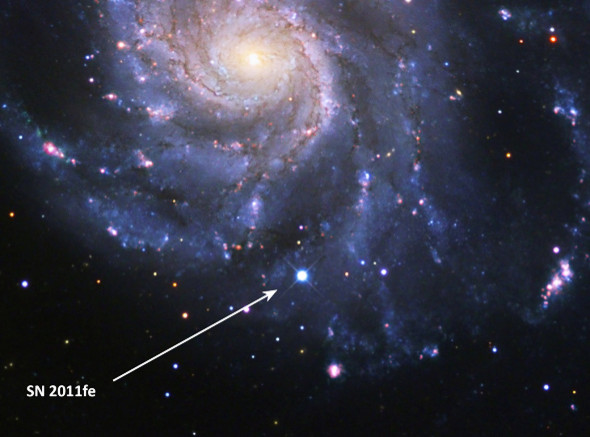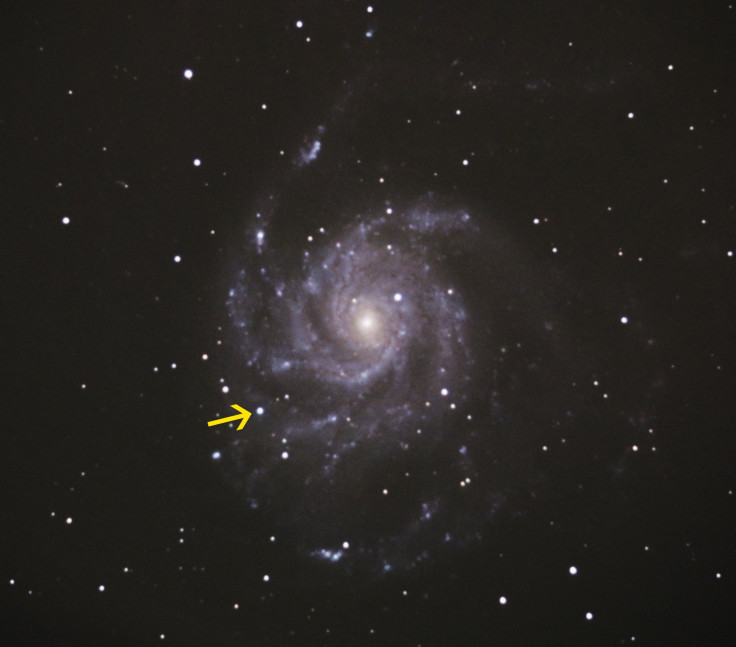Supernova 2011fe is Remarkably Normal, Becomes Standard For Future Research
Supernova 2011fe burst onto the galactic scene in 2011 and immediately became the object of much observation and research by astronomers. With so much data collected, the observations of SN 2011fe will serve as the standard against which other supernovae will be judged.

Palomar Transient Observatory discovered the supernova shortly after the star exploded, and due to its proximity to Earth, the supernova was easy to observe. SN 2011fe exploded in the Pinwheel Galaxy, M101, located 21 million light-years from Earth in the constellation Ursa Major.
SN 2011fe was incredibly close, and extremely bright, Type Ia supernova, caused when a white dwarf accumulates so much matter from its companion star that it becomes unstable, leading to the death of the star. Type Ia supernovas have been used by researchers to observe distances in distant galaxies and even helped prove the existence of dark matter as well as acceleration of the universe’s expansion.
Astronomers dubbed SN 2011fe the “Backyard Supernova,” according to the press release from Lawrence Berkeley National Laboratory. Astronomers from the International Nearby Supernova Factory, or SNfactory, were able to track the supernova from its birth to its brightest peak to its death, over the course of 32 days. The study was published in the journal Astronomy & Astrophysics.
The research, led by Greg Aldering, from the U.S. Department of Energy’s Lawrence Berkeley National Laboratory, used data collected by the SuperNova Integral Field Spectrograph two weeks before SN 2011fe reached its peak brightness until the supernova faded three months later. Aldering said, “Our measurements showed how remarkably normal 2011fe is.” Researchers measured changes in wavelength intensity across various spectrums of light.
Rui Pereira, from the Institut de Physique Nucléaire de Lyon, believes the research of SN 2011fe will serve as a benchmark for future supernovae research. Type Ia supernovae, according to the researchers, can be used to fit a standard because changes in light are directly related to time. As such, measurements can be “stretched,” so while not all light curves are the same, they can be made to fit previous graphs, notes the news release.
SN 2011fe became the perfect research subject as its distance from M101 had been previously measured and the lack of dust meant no distortion in spectrum readings. “The SN 2011fe atlas offers unprecedented detail and a solid point of reference for Type Ia physics. We’ve never had data like this. It’s a dream opportunity to stimulate deeper thinking about these markers of the expansion of the universe,” Aldering said.

The only oddity of SN 2011fe will prove to be of the most value to researchers as the light curve of the supernova did not fit any previous graphs and it could not be stretched to match past standards. “To date it has been a little too easy to cobble data together, depending on what you think it should be,” said Aldering.
Regarding Type Ia supernovae, it is believed they are formed like SN 2011fe or SN 2009ig, called a single-degenerate model, or when two white dwarf stars collide, called a double-degenerate model. According to the researchers, the light curve of SN 2011fe at times fit a single-degenerate model, at other times, the double-degenerate model, and sometimes neither. Aldering believes that this variation means there is plenty of room for improvement within each model.
Another possible point of observation of future Type Ia supernovae could be unburned. The researchers believe leftover carbon could support the theory that Type Ia supernovae ignite and then explode, called pure turbulent deflagration, instead of two different explosions. How different Type Ia supernovae burn off carbon or other material could also be something researchers explore in the future.
© Copyright IBTimes 2024. All rights reserved.






















